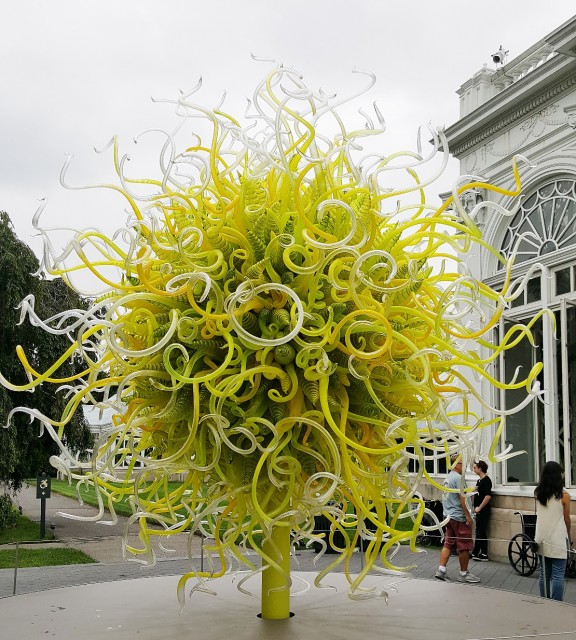CHIHULY
08/24/2017 Furniture & Decorative Arts

World-renowned glass artist Dale Chihuly first exhibited at The New York Botanical Garden in 2006. This year’s CHIHULY exhibition builds on the techniques and forms he used over a decade ago and pays homage to other ground-breaking Chihuly installations, including Artpark in 1975 and Chihuly Over Venice in 1996. The current exhibition reveals Chihuly’s artistic process and development in his design style, which often incorporates the play between color and light. It combines Chihuly’s organic forms in glass with the various natural forms of flora from the Garden, including over twenty installations of glass and some of Chihuly’s design drawings spanning his early works to large-scale site-specific installations.
Chihuly is often known for bridging the gap between craft and fine art by manipulating the vessel form. As one of the early players in the American Studio Glass Movement, Chihuly participated in a glass program for artists located at the University of Wisconsin-Madison in 1966, which was the first glass program of its kind and launched in 1962. After completing the program, Chihuly studied at the Rhode Island School of Design. In 1968, he was invited to study at the Venini factory in Venice under a Fulbright Scholarship, providing him with an unprecedented learning experience for American glassblowers. Following his fellowship, Chihuly established the glass program as RISD, where he taught for many years. In 1971 he founded Pilchuck Glass School on a farm north of Seattle, which was designed as a non-profit glass school and gathering place for glass artists to learn and share ideas and techniques.
The galleries at LuEster T. Mertz Library at The New York Botanical Garden give a chronological view to Chihuly’s works. From early on, Chihuly thought of glass outside of the traditional format and sought new techniques to expand upon different forms and colors. Showcased in the galleries are Chihuly’s early vessel-formed small-scale works, including Seaforms, Baskets, Cylinders and Macchias. The various forms and colors illustrate the fluidity of glass in its heated form. The watercolor drawings reveal preliminary sketches of his designs -- each blown glass form begins as a sketch. The library also includes the Large Palazzo Ducale Tower, one of Chihuly’s earliest towers intended to interact with the classical architecture of the Doge’s Palace from the Chihuly Over Venice show.
As he was one of the first American artists to work at the famed Venini firm on the island of Murano, it was fitting that Chihuly was invited to showcase his work there as part of the Venezia Aperto Vetro, the first international biennial for contemporary glass art. In 1995, Chihuly Over Venice displayed Chihuly’s masterpieces on canals and piazzas. Here he first experimented with the large tower. Years prior, Chihuly began completing large-scale and site-specific installations. His first chandelier was created in 1992 for the Seattle Art Museum. The tower is also often associated with his Garden Cycle works, which he started in 2001 to push the boundaries of glass and the landscape.
Each large installation or tower is mocked-up in Chihuly’s studio before arriving at its final location. Chihuly made drawings and worked with his team to create each piece in his studio, while documenting the process. Often consisting of hundreds of individual blown-glass pieces in varying shapes and sizes, it took precision and care to achieve the desired outcome.
Several large-scale works in CHIHULY refer to previous Chihuly exhibitions. In the Native Plant Garden, Koda Study #1 and Koda Study #2 reflect on Chihuly’s 1975 residency at Artpark in Lewiston, New York, where Chihuly and his collaborator Seaver Leslie placed various sized grids of glass in the landscape and broke them apart. The geometric glass panes of the Koda Studies in the landscape at the Garden juxtapose with the rectangular pools. Koda Study #3’s colorful panes in the Enid A. Haupt Conservatory Courtyard’s Tropical Pool complement the vibrant water plants.
In the special exhibition galleries of the Enid A. Haupt Conservatory, unique glass forms are interspersed among the beautiful summer flowers. The Garden’s horticulturists took care to pair interesting plants with Chihuly’s pieces. Dynamic fantastical pieces of glass not based on any specific plant are found among tropical plants.
One of the most striking elements of the Conservatory was the Macchia Forest. Chihuly created the Macchia series to use every color available in his vessels. By layering different colors of glass over thin layers of white, he prevented the bright colors from bleeding into each other. Macchia translates to spotted in Italian, and various colored glass chips are fused to the outside surface giving the pieces a dappled pattern.
The CHIHULY show captures decades of glassblowing skill and techniques by interposing complex large-scale works among the landscape of The New York Botanical Garden and individual pieces in conjunction with the smaller exhibit spaces.
CHIHULY
On view through October 29, 2017
The New York Botanical Garden
2900 Southern Boulevard
Bronx, NY 10458
NYBG.org